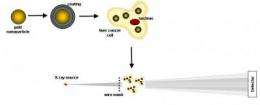Gold nanoparticles help earlier diagnosis of liver cancer

Hepatocellular carcinoma is the most common cancer to strike the liver. More than 500,000 people worldwide, concentrated in sub-Saharan Africa and Southeast Asia, are diagnosed with it yearly. Most of those afflicted die within six months.
A big obstacle to treatment of liver cancer is the lack of early diagnosis. Current techniques, including ultrasound, CT and MRI scans, spot tumors only when they have grown to about 5 centimeters in diameter. By that time, the cancer is especially aggressive, resisting chemotherapy and difficult to remove surgically.
Now a research team led by Brown University reports some promising results for earlier diagnosis. In lab tests, the team used gold nanoparticles ringed by a charged polymer coating and an X-ray scatter imaging technique to spot tumor-like masses as small as 5 millimeters. The approach, detailed in the American Chemical Society journal Nano Letters, marks the first time that metal nanoparticles have been used as agents to enhance X-ray scattering signals to image tumor-like masses.
"What we're doing is not a screening method," said Christoph Rose-Petruck, professor of chemistry at Brown University and corresponding author on the paper. "But in a routine exam, with people who have risk factors, such as certain types of hepatitis, we can use this technique to see a tumor that is just a few millimeters in diameter, which, in terms of size, is a factor of 10 smaller."
The team took gold nanoparticles of 10 and 50 nanometers in diameter and ringed them with a pair of 1-nanometer polyelectrolyte coatings. The coating gave the nanoparticles a charge, which increased the chances that they would be engulfed by the cancerous cells. Once engulfed, the team used X-ray scatter imaging to detect the gold nanoparticles within the malignant cells. In lab tests, the nontoxic gold nanoparticles made up just 0.0006 percent of the cell's volume, yet the nanoparticles had enough critical mass to be detected by the X-ray scatter imaging device.
"We have shown that even with these small numbers, we can distinguish these [tumor] cells," Rose-Petruck said.
The next step for the researchers is on the clinical side. Beginning this summer, the group will attach a cancer-targeting antibody to the nanoparticle vehicle to search for liver tumors in mice. The antibody that will be used was developed by Jack Wands, director of the Liver Research Center at Rhode Island Hospital and professor of medical science at the Warren Alpert Medical School of Brown University.
"We have developed a monoclonal antibody that targets a cell surface protein highly expressed on liver cancer cells," Wands said. "We plan to couple the antibody to the gold nanoparticles in an attempt to detect the growth of early tumors in the liver by X-ray imaging."
The researchers say the X-ray scatter imaging method could be used to detect nanoparticle assemblies in other organs. "The idea should be that if you can figure out to get that [nanoparticle] to specific sites in the body, you can figure out how to image it," said Danielle Rand, a second-year graduate student in chemistry and the first author on the paper.
Provided by Brown University

















